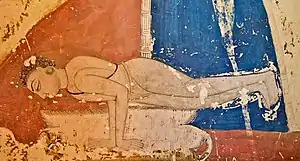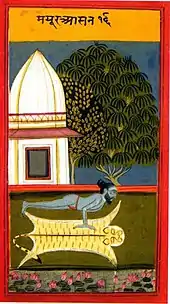Vimanarcanakalpa
The Vimānārcanākalpa is a 10th to 11th century text on Hatha yoga, attributed to the sage Marichi.
Text

The Vimanarcanakalpa is a 10th to 11th century prose text[1][2] on Hatha yoga, attributed to the sage Marichi.[3] It states that yoga is the union of the individual with the supreme self.[4]
It is one of the earliest texts to describe a non-seated asana and to call such postures asanas (the term originally and literally meaning a seat), namely Mayurasana the peacock pose. In chapter 96 it describes nine asanas in all (Brahmasana, Svastikasana, Padmasana, Gomukhasana, Simhasana, Muktasana, Virasana,[lower-alpha 1] Bhadrasana, and Mayurasana), some 500 years before the Hatha Yoga Pradipika.[5] Its account of Mayurasana, in James Mallinson's translation, is:
Fix the palms of the hands on the floor, place the elbows on either side of the navel, raise the head and feet and remain in the air like a staff. This is the peacock posture.[6]
The text teaches a method of pratyahara, withdrawal using the breath, which is raised through 18 stages called marmans, vital points.[7]
The Vimanarcanakalpa describes other topics, such as the practice of burying sacred bronze objects to protect them in times of trouble.[8]
Notes
- Called hero's posture, but as a cross-legged pose not the same as the modern kneeling Virasana.
References
- Marichi 1926.
- Huesken, Ute (2 November 2002). "VaikhAnasa saMhitAs". Ramanuja.org. Retrieved 1 February 2019.
- Mallinson, James (9 December 2011). "A Response to Mark Singleton's Yoga Body by James Mallinson". Retrieved 4 January 2019. revised from American Academy of Religions conference, San Francisco, 19 November 2011.
- Mallinson & Singleton 2017, p. 21.
- Mallinson & Singleton 2017, pp. 87, 100–101.
- Mallinson & Singleton 2017, p. 101.
- Mallinson & Singleton 2017, pp. 174, 190, 285, 296.
- Nagaswamy, R. "Eslam Bronzes and Copper-plates". Tamil Arts Academy. Retrieved 1 February 2019.
he Vimanarcanakalpa, (Marici text) published in Madras, 1926, Chapter 70, pp. 435-439, gives in detail the process of concealing metal images in times of emergency and restoring them to worship. The chapter is titled Bhaya-raksartham Niskrtih.
Sources
Primary
- Marichi (1926) [c. 1000]. Vimanarcanakalpa (in Sanskrit).
Secondary
- Mallinson, James; Singleton, Mark (2017). Roots of Yoga. Penguin Books. ISBN 978-0-241-25304-5. OCLC 928480104.
